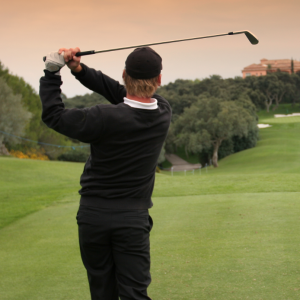Shoulder stability
Following on from the last article on back mobility the shoulder is the next joint to look at to ensure you get the most out of your golf.
The shoulder is a highly mobile joint, for it to make movements like swinging a golf club, an overhead smash in tennis, swimming or paddling it needs stability to control. The glenohumeral joint (the ball and socket) of the shoulder can be liked to a golf ball on a tee, so for it to work well it needs to be controlled/stabilised in that position, when you move your arm there is an element of roll and slide within the joint to make movement possible and if this is not effective this may lead to pain.The rotator cuff muscles along with the ligaments of the shoulder aid in stability and movement along with larger muscles which support the shoulder girdle (collar bone and shoulder blade). Stabilising the whole shoulder girdle sets a strong base for movement of the entire upper limb which enables us lift objects in front and overhead. Many of us experience pain in the upper shoulders and neck from sitting and working at a desk all day, and this too could be attributed to a lack of endurance in these muscles stabilising the shoulder.
To avoid the pain of shoulders and to be able hit the golf ball well, swim pain free or just hang out the washing we need to work on maintaining and improving our overall shoulder stability and strength. As the rotator cuff suggests it is mainly responsible for rotary movements of the shoulder and we should therefore strengthen through full range, this can be done by working each of the muscles individually or more easily we can perform exercise that take the shoulder through much of its range as this then requires all muscles to work together to make the movement happen.So to maintain shoulder position to get the best result from your golf swing or any other pursuit here are a couple of exercise to add into your routine.
Wall slides- Stand with your back against a wall and bend your knees a little.
- Your shoulders and head should be touching the wall
- Start with your upper arms at your side with your elbows bent.
- Your wrists and forearms should be touching the wall.
- Bring your arms up as high as you can get them, without any of your body parts coming away from the wall.
Mini Band Raises
- Take a small resistance band and hold between both hands, bend forward form the hips to about 45 degrees.
- Start with your elbows by your side and hands in front of your body with light resistance on the band.
- Palms facing together reach arms out in front of you keeping shoulder blades back.
- As you elbows straighten pull your arms further apart and continue to raise hands over head hold for 3 sec and return o the start position.
Reverse flys
- Bend forward from the hips to almost horizontal, the spine should be in a neutral.
- Keeping your elbows slightly bent, lift the arms up and out to the side, squeezing your shoulder blades together.
- Control the movement back to the start position.

